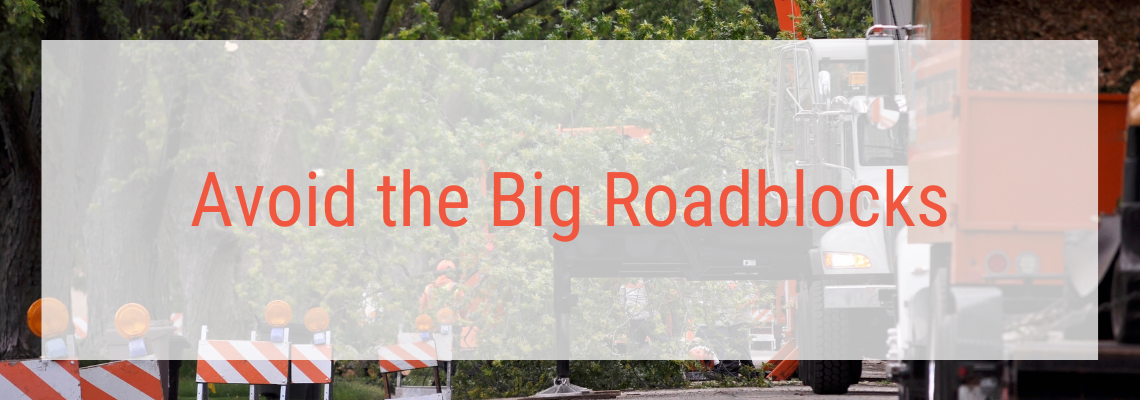Are you reflecting on the progress you’ve made in your game over the last year? Perhaps you didn’t get as far as you’d hoped by now. Maybe you’re uncertain about how to move your game forward. I’m here to help. Using a simple two-part process you can gear up for better golf in the New Year starting now.
In my monthly membership program I’m in the process of teaching my clients how to map out their goals for 2020. Better than mere goal setting, goal mapping gives you an actionable game plan to follow taking the guesswork out of getting from where you are to where you want to be. But before you begin setting your sights on a destination you’ve got to make sure you aren’t putting any roadblocks in your path.
Avoid the Mindset Roadblocks That Prevent Progress
You work hard on your game and want to see the fruits of your labor on the course. If you’re not be seeing the improvements you think you deserve you may be operating with common mindset roadblocks.

The three big ones to avoid are:
- Setting the acceptable performance standard at perfection –
I bet you love to hit pure shots. We all do. Because those are the “money” shots, the fun shots, and the ones that feed your ego. But to make hitting perfect shots the ultimate goal is unrealistic. You aren’t a robot. Setting the acceptance bar that high leaves you with no other option than to continually fall short. It opens the door to nitpicking the details of your shots.
Have you ever thought, “That was a great shot but…” and then considered what still could have been better? Is good is never quite good enough?
Success begins by setting goals you can actually reach. Think about one thing that could help you hit more fairways, increase your GIR, or get the ball a foot closer to the pin with your wedge game. Setting high but realistic goals is the smart approach that leads to rapid improvement.
- Losing sight of the high impact of small improvements –
When evaluating your game do you look for the lowest hanging fruit opportunity that could save you one more stroke per round? It’s important that you don’t get wrapped up working on a big change. With your swing coach or mental coach look for your best small, high value adjustments that could make a big difference.
An example might be improving your self-talk on the green to increase your confidence over short putts. A simple improvement like this could manifest in a smoother, more consistent stroke that gets more putts to drop.
Investing just a bit more attention to a small improvement won’t prevent you from making big changes elsewhere. If the ultimate goal is to lower your score, it shouldn’t matter how you make that happen.
- Tracking your failures more than your successes –
Many clients set their goals around decreasing the negative parts of their game instead of increasing the positive. Tracking your failures simply makes them your primary focus. And what you spend the most time thinking about tends to be what you produce more often.
When you make a point of keeping stats on your successes you reinforce repeating them. Measure the micro improvements in every shot rather than evaluating the worth of shot based on the outcome alone. In golf, you can directly control the HOW (your process) but not the WHAT (the result). I teach my clients how to improve their outcomes by better managing the process of every shot.
You can’t hit more consistently solid shots if your mindset isn’t consistently solid. When setting goals be sure you’re focused on advancing the parts of your game you can actually influence.
Create Your Success Map
Once you’ve identified some small, attainable, realistic, but challenging goals while avoiding the mistakes above you’re ready to create your map.

There are five main ingredients that make up a successful roadmap.
1 – The Destination
Always begin the process of goal mapping by identifying your desired finish line. You’ve got to get specific about what you actually want to achieve. Lowering your handicap is too vague. Set a more clear objective like improving your putting average by 4 shots.
2 – The Starting Point
Once you’ve decided where you want to go, the next step is knowing where the start line is. If you’re like most golfers you likely keep some statistics on your game. If that’s not the case, then you’ll want to get some baseline numbers on the part of your game you want to improve.
Let’s say you want to dial in your proximity to the flag on your chip shots from 60 to 45 yards off the green. You’ll need to know what your current average is when hitting those shots. If your starting point is an average proximity of 20 feet from the flag and you’d like to get more shots within 15 feet you will be clear about where you are and where you want to go.
3 – The Timeline
Nothing’s more discouraging than setting goals but not having enough time to actually reach them. You’ve got to be honest about your timeline. Don’t plan to make improvements in your game two weeks before the club championship. If you want to see growth in your game give yourself the time and space to grow.
For example, if you’ve got 2 months to work with you can break your big goal into smaller chunks. Going back to the putting example, it would make sense to set 4 mini-goals over the two month period. Create a strategy that will help you save one putt per round on average by the end of week two, and then another one putt improvement by the end of week four and so on.
4 – The Metrics
To know that your improvement plan is working you must be able to track your progress as you go. Once you’ve got a practice plan in place keep track of your numbers daily.
Avoid going to the range or heading out to play without being clear about what you plan to accomplish and how. When you are purposeful in your approach you will position yourself to make incremental progress toward your end goal.
5 – The Mindset
Probably one of the most important, but often neglected, parts of successful goal mapping is your mindset. You will slow your growth, or stall it completely if you are operating with any negativity, self-doubt, or lack of engagement and enthusiasm. To reach your finish line you must support your work with a disciplined and focused mind.
Like everyone else, you are your own worst critic when it comes to your game. And it’s easy to focus on your mistakes over your baby step gains. You might get stuck thinking about how far you have yet to go versus how far you’ve come. Operating with the right mindset can expedite your learning no matter how big or small your end goal is. So police your thoughts and emotions at all times so you can keep your mind and game on the road to success.
Believe in a Better Game
I’ve spoken with hundreds of golfers over the years who had nearly given up on the hope of having a better game. Does that sound familiar? The only reason you can’t play better is if you decide that you can’t.
No matter what level you play when you invest a bit of time and energy in developing the right mindset you open up a new world of opportunity for improvement in your game. My clients are always amazed and elated by how easily things begin to improve with some simple adjustments in how they approach their game.
If this sounds like something you’d like to learn more about there are several ways to develop your golf mindset. And I’d love to help you find the right fit for your goals, timeline, and budget.
Schedule a complimentary call with me to explore your options and make the New Year your best year yet!
Just click on the image to get the ball rolling. Or leave me a comment below with your question. I am here to help.
Thanks for reading and until next time…PLAY GREAT!

Leave a Reply